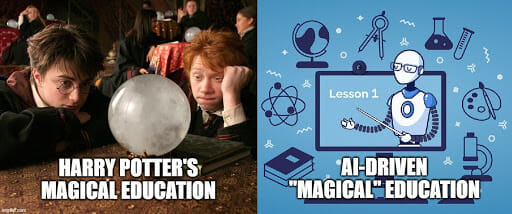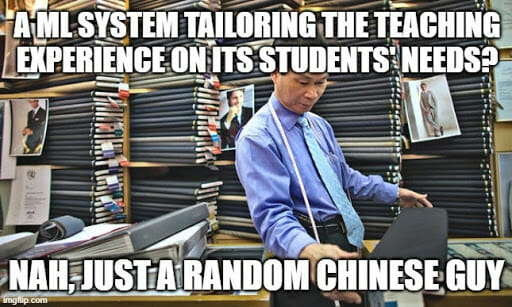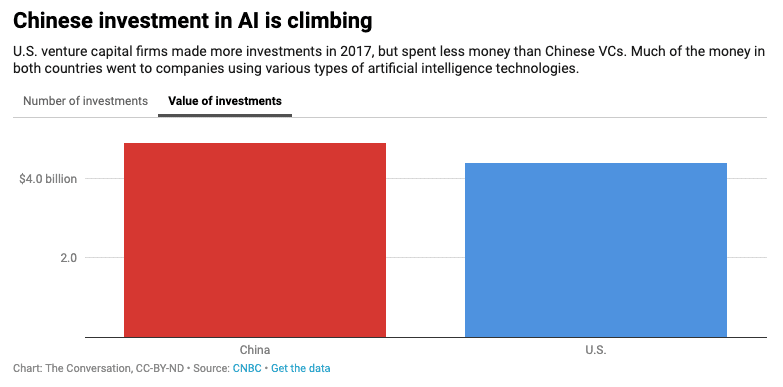The Role of Artificial Intelligence in Education

A few months ago, one of my colleagues told me that artificial intelligence works by magic.
He was obviously joking. But not too much.
Actually, AI algorithms often work in very mysterious ways and deliver incredible results.
What if we used this “magic” to enhance the educational environment? Would we get the cyber version of Harry Potter?
Not exactly.
So, how does AI affect education?
AI-based systems can contribute to education in other interesting ways:
- Personalizing the learning experience
- Making useful previsions about students’ performances
- Helping teachers do their job
- Developing efficient AI tutors and chatbots
- Supporting administrative tasks
- Turning your college into Hogwarts
AI and education today
In the field of education, technology is not just about interactive whiteboards and tablets. In recent years, artificial intelligence has played an increasingly important role in enhancing the teaching experience for both professors and students.
This fruitful relationship between AI and education is already a reality and is set to reshape the entire industry in the near future.
The opportunities for these technologies are so vast that even Microsoft has recently commissioned research on this topic.
The results showed that 99.4% of teachers believe AI will be critical to their school’s competitiveness within the next three years, with 15% calling it a “tipping point”.
In fact, 92% of professionals surveyed said they have started experimenting with AI-based educational tools.
Because it works!
No wonder about the considerable optimism regarding this tech: its potential has already been proven on the field.
For example, according to an independent study by the City University of New York and the University of South Carolina, an average of 34 hours of Duolingo is as effective as an entire college semester of language education.
And guess what? The famous language learning platform makes extensive use of AI and machine learning algorithms.
Not only linguistics
AI goes well beyond language learning!
The education industry has already developed many tech-driven solutions that can offer a wide range of services, such as analyzing the level of knowledge, providing an improvement plan, creating a clone who will study at your place, and so on.
One of them is Third Space Learning. This platform, created by London University scholars, can suggest ways to improve teaching techniques, providing feedback via notifications if the teacher speaks too fast or slow.
AI to teach maths
Another interesting platform has been developed by Carnegie Learning and is focused on mathematics. This system can analyze the users’ actions and allows the tutor to see their progress.
It can also provide more personalized teaching materials, making the learning process more comfortable.
Hey, did I just say “personalized teaching”?
Great, this brings us to the first way in which AI can boost teaching and learning. I’m gonna talk about it in the next chapter!
1. How to personalize education with AI
In recent years, most of the research regarding artificial intelligence has focused on so-called machine learning.
Machine learning (ML) is one of the newer branches of AI. It specializes in creating computer algorithms that can automatically improve their performance through experience.
By “experience”, I mean the analysis and processing of huge amounts of data.
And what should algorithms do with all this information? Maybe sell it to Cambridge Analytica?
Well, no. Rather, ML algorithms are able to recognize specific patterns in the data sets they are provided with, build mathematical models concerning these relations, and use the same models to make predictions or decisions without being explicitly programmed.
What does ML mean for education?
The unique features of ML-based systems, especially their ability to understand data and improve themselves, unlock interesting possibilities in the field of education.
The first one is to allow a more personalized learning experience. In the personalized learning model, students can choose their own learning paths based on what they’re interested in.
Consequently, teachers will fit the student’s curriculum to his interests.
ML and adaptive learning
Another approach supported by ML is adaptive learning, which analyzes a student’s performance in real-time and modifies teaching methods and the curriculum based on that data.
Both of these models require efficient learning analytics, a process of collecting, measuring, and using student data to build their personal profiles and design personalized learning pathways or update the previous ones.
Collected data usually consists of variables such as completion time, video views, test results, number of paper airplanes thrown at classmates, and so on.
A bunch of useful information that will be processed by machine learning algorithms to provide feedback and suggestions to teachers.

Personalized vs traditional learning
ML is an extremely flexible tool that can support all students regardless of their learning speeds, as opposed to more traditional (and perhaps ruthless) teaching methods.
Algorithms learn how they receive and understand information, allowing teachers to individually monitor each scholar and help them in areas where they are particularly weak.
As these technologies evolve, machines will even be able to read students’ facial expressions to notice their stress and offer the teacher to provide further explanations.
ML for real-time translation
Another way in which AI can make education easier and accessible to everyone (including those who speak different languages) is by real-time translation.
For example, “Presentation Translator” is a free PowerPoint plug-in that creates subtitles for what teachers are saying.
This allows students to be trained on particular subjects which may not be available in their own school.
2. AI-based forecasting of learning outcomes
As we said before, machine learning systems are also gifted with some sort of clairvoyance. This means that they can analyze data they are fed with and make predictions.
What kind of predictions? For example, the learning outcomes of students.
This information is extremely useful for at least two reasons. First, by knowing the students’ academic performance in advance, professors can tailor their courses and activities to suit learners’ needs before it is too late.
Secondly, as a direct consequence of the first point, it will be easier to reduce the school dropout rate.
In Illinois, for example, the State Board of Education of Illinois developed an early warning system fuelled by machine learning algorithms. The platform identifies students at risk and helps teachers choose a strategy to support and motivate them.
ML for students’ dropout prediction
Algorithms don’t just look at students’ early-stage performance to identify cases at risk. The social context and many other factors also affect the dropout rate: financial circumstances, family situation, demographic data, and many more.
By analyzing this data, early warning and detection systems can assist schools and teachers with identifying and recommending interventions even before the beginning of the courses.
Many ML models are used to help predict whether a student is at risk of dropping out of school or not graduating on time.
A few names to shock your colleagues and sound like a real pro? Random forests, SVM (support vector machines) AdaBoost, decision trees, and logistic regression.
Don’t you feel smarter already? Thank me later.
3. AI and teachers working side by side
AI doesn’t just help teachers save struggling students, like Robin Williams in the movie “Good Will Hunting”.
In addition to forecasting, algorithms can support professors in carrying out tedious and time-consuming duties, starting with the grading process of quizzes, tests, and homework.
Teachers can now choose to automate these activities with grading software, saving time for other tasks such as interacting with students and setting up the course.
What about future improvements?
Currently, ML algorithms are perfectly capable of automatically checking for multiple-choice and true-false types of answers. But in the near future, as these technologies advance, ML-based systems will also be able to evaluate essays and short answers.
This will save me and my fellow teachers a lot of time. But it will also deprive us of the sadistic pleasure of correcting tests with giant, threatening red marks.
Wanna know what else can be threatening? Go on reading!
4. AI-based tutors and chatbots
We have previously mentioned the case of Duolingo, a famous language learning platform with over 300 million registered users. This successful app is well known for its “cute” mascot that pushes us with numerous notifications to proceed with our lessons.
Actually, these “notifications” look more like death threats and blackmail. But you got the point, right?
This menacing green owl is just one of many AI-based chatbots and virtual assistants that nowadays complement (or totally replace, probably after killing them) real teachers in many educational activities.

The pros of virtual assistants
While these mentoring systems can’t beat real-world teachers yet, their strength lies in being operational 24 hours a day and offering students a flexible way to experiment and learn remotely in a relatively judgment-free environment.
Thanks to these features and the possibility of replacing teachers in some specific tasks, AI tutors will progressively shift the role of the teacher to that of a facilitator.
This means that educators will integrate AI, offering human interaction, and assisting students in need. Something that already happens in e-learning and online schools today.
How can AI tutors help us?
AI-powered assistants help students and teachers in many ways. They act as trainers, by processing an efficient learning style and offering exercises and useful materials specifically designed for each learner.
They can also offer feedback to the teacher on how each student performed in the sessions, facilitating appropriate grading.
Furthermore, virtual assistants are able to indicate areas of the course that require further explanation, providing additional resources related to that topic.
Once again, the keyword is “personalization”. This approach has also been followed by Duolingo, which uses machine learning to tailor each lesson on its platform.
Basically, the virtual assistant will process already acquired data through ML-based algorithms, to choose which sentences can help a user improve his/her weakest language skills, or to recommend practical activities based on the student’s abilities.
AI tutors speak with us thanks to deep learning
Chatbots and virtual assistants don’t use AI just to adapt to student needs.
Their very ability to communicate with humans is powered by algorithms, in particular by deep learning and neural networks that represent the latest evolution in ML technologies.
Deep learning mimics the mechanisms of the human brain to process information by using deep neural networks, interconnected layers of artificial neurons that send data to each other.
We are talking about an incredibly powerful tool, capable of allowing speech recognition, natural language understanding, and natural language generation.
Everything we need for efficient (while sometimes creepy) interactions between computers and humans!
5. AI for administrative tasks
AI in education isn’t just a useful tool for educators and students. Many other professionals are involved in this environment and benefit from our beloved algorithms.
Starting with Willie, the gruff Scottish gardener from the Simpsons cartoon.

Well, maybe not Willie.
But managers can certainly employ intelligent assistants to support various administrative tasks such as budgeting and organizing student applications and enrollments, not to mention the procedures related to human resources, and facility management.
AI to support recruiting
Second, AI systems are modernizing the way colleges interact with prospective students, supporting administrations in recruiting tasks and offering AI-driven training that can facilitate the transition from high school to college.
Another possible application in higher education concerns the reduction of human biases during the admission process, as AI-based systems use (at least in theory) neutral criteria to select admission applications.
Thanks to all these applications not directly related to teaching or learning, artificial intelligence is able to increase the efficiency and responsiveness of educational institutions, reducing their operating costs.
The future of AI-based education
According to reports, AI-driven education will skyrocket over the next five years, reaching a global expenditure of $6 billion dollars by 2025.
Much of the growth will come from China, the undisputed leader in AI research. The Asian giant is already investing billions of dollars in artificial intelligence, also focusing on education technology.

Meanwhile, my school class laptop struggles to open pdf files and detect my pen drive.
Should I ask China or the US to invest in my educational tech tools? Write it down in the comments!
Need support with your software development?

Andrea Di Stefano
Andrea is a journalist and teacher of Italian with a long-standing interest in tech and media. He loves to handle touchscreens, but to correct his students’ homework he prefers the good old red marker on paper!
